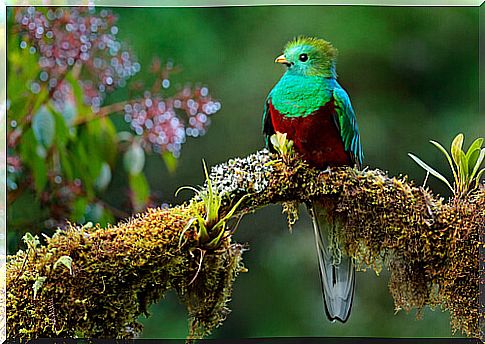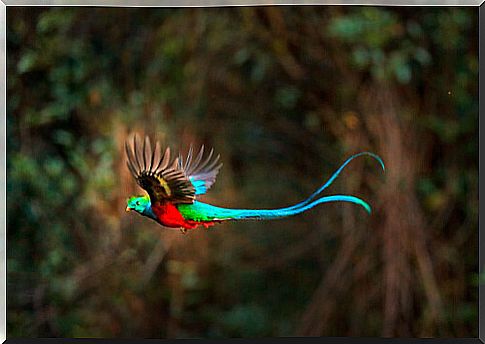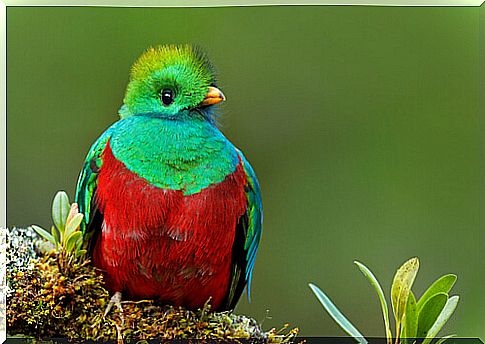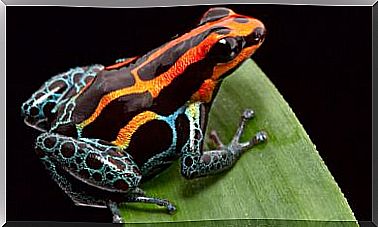The Legendary Quetzal Of Mesoamerica

The quetzal is an iconic bird of Central America, particularly because of its connection to the Aztec god Quetzalcóatl. Its bright green plumage with iridescent hues has led many to classify it as one of the most beautiful birds in the world. Although it is generally out of danger of extinction, the destruction of its natural habitat threatens the resplendent quetzal.
The legend of Quetzalcóatl
The quetzal takes its name from the legend of Quetzalcóatl. This was a Mesoamerican deity venerated from 1 BC to around 1500 AD. The name Quetzalcóatl means “feathered serpent” in Nahuatl, spoken by the Aztecs in Central America.
Quetzalcóatl was the main God of the Aztec worldview. Rulers and nobility wore headdresses made from the bright green quetzal feathers, which symbolically connected them to the god. It was considered a crime to kill this bird, so the feathers were obtained by capturing it, plucking its long tail feathers and then releasing it.
Classification and habitat
Quetzals are birds of the Trogonidae family, genus Pharomachrus, that inhabit tropical forests around the world. According to the Encyclopedia Britannica, this bird lives from southern Mexico to the Bolivian Amazon.

Varieties of species
There are five different types of quetzals, all native to the American continent.
Golden-headed quetzal (P. auriceps)
This species is known for its bright green color that contrasts with the golden head. This bird is relatively common in Central and South America, where it lives in humid forests. It feeds mainly on fruits and to a lesser extent on insects. Like other quetzals, it is a solitary bird that only meets during the reproductive season.

Fulgid quetzal or golden quetzal (P. fulgidus)
This species lives mainly in cloud and humid forests of the Caribbean coast in Colombia, Guyana and Venezuela. As in other quetzals , only the male has distinctive colors : the golden yellow bill and bright green feathers are characteristic. It feeds on fruits, berries, and insects.
Crested Quetzal (P. antisianus)
This bird lives in pristine forests in the Andes between 1200 and 3000 meters high. The head and neck of the male are metallic turquoise, while the trunk is vibrant red.
As in the case of other quetzals, the females are dull in color, mainly brown and green. These specimens are distinguished mainly by the characteristic crest of adult males. The ridge grows just above the peak.
Pavonino quetzal (P. pavoninus)
Also known as “red billed widow”, this is one of the quetzals that least resembles the well-known resplendent quetzal. This bird is native to the Amazon River basin, between Venezuela, Colombia and Bolivia; and it is the only one of its kind that lives east of the Andean mountain range.
This species has bright colors, particularly in males. These exhibit a bright red bill, while the females have a duller color.
Resplendent quetzal (P. mocinno)

The resplendent quetzal is an iconic bird of Central and South America. In fact, it is the national bird of Guatemala and gives its currency its name. There are two subspecies, P. m. costaricensis and P. m. mocinno.
It has an iridescent green body and a red breast. Depending on the light, quetzals glow green, cobalt, yellow, and even blue. This bird is distinguished by its long tail, which can measure more than 60 centimeters.
An endangered species
Of the five species of quetzal, four are not considered endangered. However, the resplendent quetzal is listed by the International Union for Conservation of Nature (IUCN) as “near threatened”.
Furthermore, the US North American Bird Conservation Initiative (NABCI) also lists the resplendent quetzal on its “Watch List” as a species of high conservation concern.
Today, the greatest threat to this spectacular bird is the loss of its natural habitat. Deforestation, forest fragmentation, and agricultural logging are the main risk factors for the resplendent quetzal.








